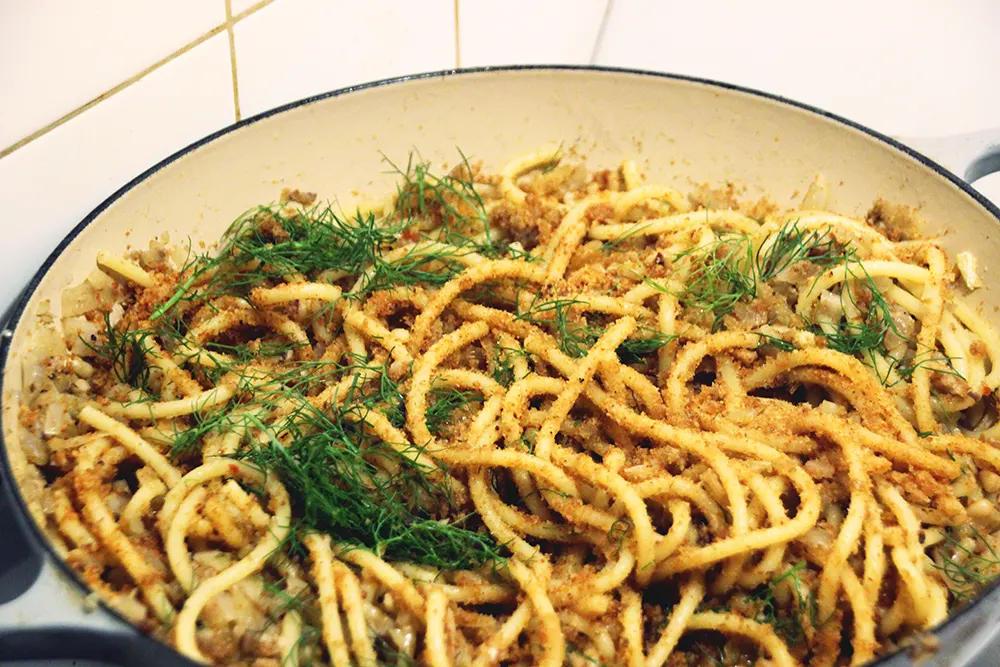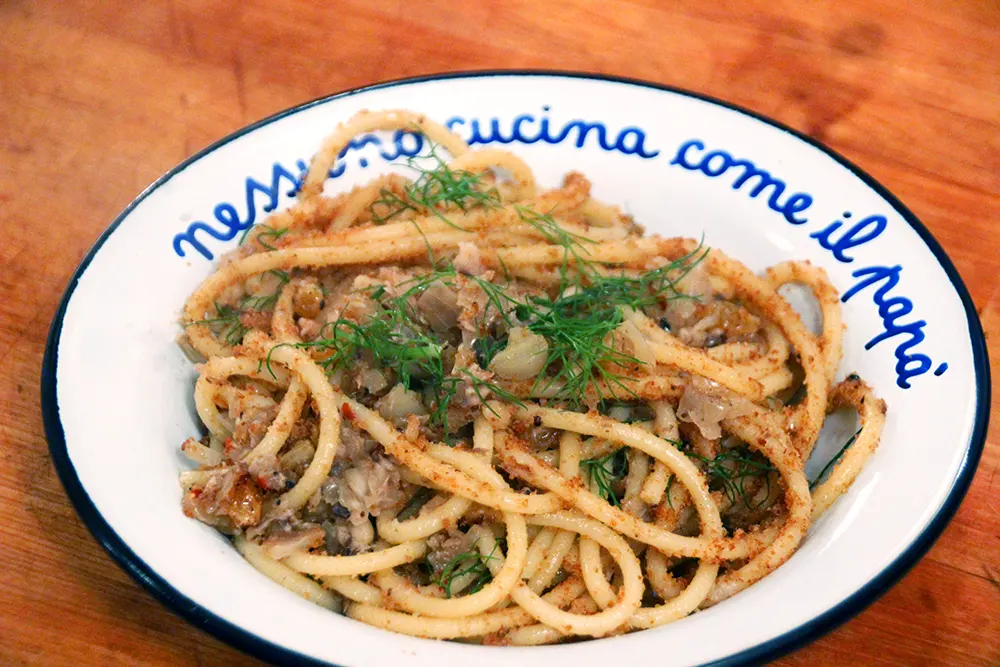The History of Pasta Con Le Sarde
By Ian MacAllen on Monday, March 11th, 2024 at 2:24 pm | 1,507 views

Macaroni con le sarde, or a pasta con le sarde, is a traditional Sicilian pasta made with a sauce of fresh sardines and fennel greens and tossed with toasted breadcrumbs. While a common dish in Sicily, it’s less well known in the United States, except perhaps, in New Orleans where it has become the cornerstone of the St. Joseph’s Day celebration.
Macaroni con le sarde can be traced back to the 9th century during the Muslim conquest of Sicily. It’s similar to a dish prepared with anchovies, known as spaghetti alla syracusana, which is also from that period. The key component of the dish is the combination of savory flavors from the fatty sardines and the sweetness from fennel and golden raisins, as well as the crispy fried breadcrumbs.
There is no “correct” version of the recipe with many slight variations commonly consumed under the same name. Pellegrino Artusi’s 19th century recipe includes mixing both fresh sardines and salted anchovies. And while Artusi includes fennel, the simple recipe omits other ingredients like sultanas or pine nuts, both more common today.
In the 1970s, the Italian government, looking to bolster Sicilian tourism, published recommended local specialities of the island. The Macheroni con le sarde of this era included fresh fish, pine nuts, fennel, spices, sardines and olive oil.
The recipe varies across the island. In Palermo, the sauce is usually made without tomato sauce, but in other cities, tomato paste or tomato sauce might be used. White wine is another variant, added for acidity. Fresh fish is essential to the Italian recipe, but in the United States, pasta con le sarde typically calls for jarred sardines preserved in oil. That’s how the pasta is made in New Orleans.
New Orleans’s Italian immigration dates back to even before the diaspora beginning in the 1880s, and then accelerated through that period. New Orleans has a huge percentage of immigrants who arrived from Sicily, second only to New York City, and many of the traditions in the New Orleans Italian American community reflect that origin.
New Orleans, as a major port city exporting agricultural products from the Mississippi valley, also imported many European products. Oranges from Sicily and dried macaroni made their way into the United States through the port, and eventually Sicilian immigrants settled in the city as well. Following the American Civil War, Sicilians were actively recruited to help replace slave labor.
By the 1880s, as Italian immigration surged in the United States, Sicilians increased in number in New Orleans. As many as 290,000 Italians arrived in the city and settled a neighborhood that eventually became known as Little Palermo, a subsection of the French quarter.
Little Palermo was filled with Italian-owned small businesses. This included places like Angelo Brocato, an ice cream parlor and bakery first established in 1905 with a location at 518 Ursulines Street, and Central Grocery on Decatur Street. Central Grocery also gave the world the Muffaletta Sandwich, a unique type of Italian hero served on a Sicilian-style bread.
Despite making up a large part of the New Orleans community, people of Italian and Sicilian descent were looked down upon by New Orleans society. The Italian American St. Joseph Society of New Orleans was founded to help elevate Italian culture in the city, and earn the respect of other ethnic groups.
The origins of the St. Joseph’s Society dates back to the late 1960s. According to Peter Gilberti, the president of the organization, the founders Joseph Cardenia and Jimmy LaCava had attended an Irish heritage parade when, after the parade had ended, a group of men drove around throwing bananas at passersby. The racist undertone of the assault might be seen as an anti-Italian hate crime today.
The incident led Cardenia and LaCava to team up with their friend Tony Russo, a lawyer and magistrate to form the Italian American Marching Club in 1970. The group intended to promote Italian American culture in the city. In 1974, for instance, they declared a world champion meatball eater. Mike Palmisano ate 20, three-ounce meatballs in fifteen minutes.
Ultimately, New Orleans is a city defined by parades, and the Marching Club sought to fuse Italian culture with local traditions. The club began celebrating St. Joseph’s Day in the New Orleans way: with a parade.
The Feast of San Giuseppe is popularly known as “Italian Father’s Day, and in English, the Catholic holiday is called St. Joseph’s Day. The feast is a celebration of Joseph, the husband of Mary. Other Italian American enclaves may celebrate by making special pastries, but in New Orleans, the feast is a weekend-long festival that includes a parade, debutante-style ball, and a giant bowl of pasta con le sarde.

The early members of the Italian American Marching Club also happened to be muscle car enthusiasts. In the first iteration of the parade, they decided to integrate their passion for fast cars with their love of St. Joseph. And since they also lived in the Southern United States, they merged the southern tradition of debutante balls; each muscle car carried young “maids” dressed in white, one of whom was declared a queen.
In the first years, the parade also featured school bands and a few decorative floats. Members of the marching club wore tuxedos and carried canes and Paper-mâché flowers. By the 1980s, more floats were added to the parade replacing the muscle cars. The floats were designed to mimic the St. Joseph Day altars. Across southern Italy, Sicily, and in New Orleans, altars are created in honor of St. Joseph. These are sometimes known as la tavala di San Giuseppe, the table of San Giuseppe. They include breads baked in the shape of fish, hammers and carpentry tools, and other objects associated with Joseph. Fruit and prepared food also adorns the altars and photos of people who have passed away. These altars were traditionally created in Italian homes, churches, and public places like schools, and are now integrated into the parade with special floats.
The St. Joseph’s Day parade takes place on the Saturday closest to the feast day of March 19, and this year the parade falls on March 16. However, the celebration begins on Friday night, March 15 with the Pasta Dinner, open to the public and featuring the world’s largest bowl of Pasta con le sarde.
The founding of the club in the 1970s corresponds to the increasing notoriety of pasta con le sarde. American magazines like Town & Country and Cosmopolitan, and regional newspapers published travel articles highlighting the dish from the late 1960s through the 1980s. The recipe was presented as a delicacy of Sicily rather than a dish available in the states, something to be sought out while on the island. For an organization dedicated to promoting Italian culture, particularly in a city with a large percentage of Sicilians, pasta con le sarde was the perfect expression of that identity.
The St. Joseph’s Society hosts the dinner at the Hilton New Orleans Riverside and will cook up hundreds of pounds of macaroni, usually bacutini donated by De Cecco. This year it will include 500 pounds of pasta and 120 gallons of sauce (gravy, depending on your preference) made with sardines and anchovies. The pasta will end up in an eight foot by eight foot bowl.
The head chef is David Greco, the creator of Arthur Avenue Italian Deli, Mike’s Deli, and The Bronx Beer Hall in New York City, who comes to New Orleans to oversee the pasta. He starts early in the morning, before dawn, to ensure the pasta is ready for the noon luncheon. Before the pasta is served, the organization awards scholarships to the maids, and giant “walking heads,” emerge. These Papier-mâché costumes are oversized heads common in New Orleans, and the St. Joseph’s society usually has characters relevant to Italian American culture.
“Bring forth the pasta!” Peter Gilberti will declare, and the hotel staff will carry trays of pasta to the enormous bowl and then top it off with sauce.
The parade follows the next day wending its way through the French Quarter and ultimately ends up back at the local Hilton ballroom where the organization holds a gala. The gala isn’t a formal dinner, but does require membership in the organization. The gala is a decidedly lighter meal, usually serving Muffaletta sandwiches and Italian cookies, with members bringing additional food.
Pasta con le Sarde still isn’t wildly popular in the United States outside of New Orleans. It can be found of course, particularly in Sicilian-focused restaurants. Meanwhile in Sicily, and even some of the surrounding islands, the dish is wildly popular and still frequently recommended at many restaurants–so much so, it might be hard to find recommendations other than pasta con le sarde.
Historic Recipes
Maccheroni con Le Sarde Alla Siciliana
Adapted from Pellegrino Artusi, Science in the Kitchen and the Art of Eating Well, 1891
Ingredients
500 grams Neapolitan Macaroni
500 grams fresh sardines
6 salted anchovies
300 grams wild fennel
Instructions
Filet the sardines.
Salt and fry.
Set fish aside.
Boil the wild fennel until tender.
Chop and set aside.
Cook macaroni, set aside.
Heat anchovies in oil
Add the fennel.
Add tomato sauce
Combine remaining ingredients.
New Orleans St. Joseph’s Day con sarde
Adapted from a New Orleans Times-Picayune recipe originally published in 1995
Ingredients
3 onions
4 ounces canned anchovies
6 ounces tomato paste
18 ounces tomato puree
15 ounces tomato sauce
2 1/2 cups water
basil leaves
sugar
1 can Cuoco Seasoning for Macaroni with Sardines
1 fennel
Instructions
Cook onions and anchovies.
Add tomato pasta, sauce, and puree.
Add water.
Simmer.
Add sugar, salt, pepper to taste.
Chop fennel.
Add to sauce and simmer.
Cook for about an hour.
Add macaroni seasoning.
Continue cooking about an hour.
Combine with bucatini.

